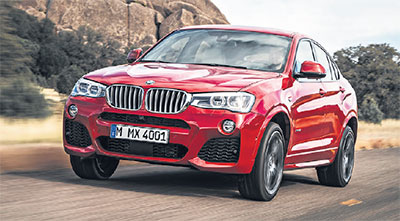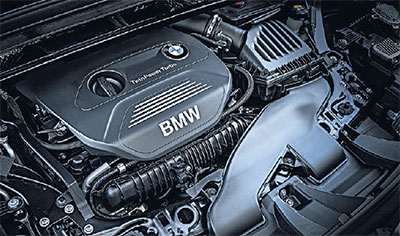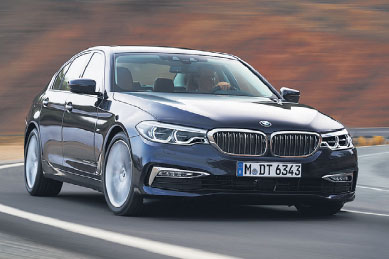

Not so long ago, it was commonplace to lift the bonnet on a full-size BMW, Volvo, Jaguar or Land Rover and see at least six cylinders in there, with a V-8 also being a regular resident.
Oh, how times are changing. It is increasingly typical to see a much more compact, four-cylinder power plant in autos like these. Four-in- a-row may be business as usual for garden-variety grocery runners and budget rides. But in the past few years, these smaller motors have taken up position under much more prestigious bonnets.
Pushing this fundamental switch is the drive to achieve lower petrol consumption numbers and cleaner exhaust emissions — no surprise there. The smaller motors, with reduced capacity and lower horsepower, can be expected to burn less fuel and generate fewer emissions.
But how to ensure that these larger luxury vehicles will still have the same stoplight jump and athletic acceleration that is expected in this pricier ownership club?
CLEVER MECHANICALS
Enter the ingenuity of turbocharging.
It’s amazing what can be
accomplished by simply jamming
more air into an internal combustion
motor. A small engine suddenly
grows big muscles.
It’s not that turbocharging is a new idea. The problem in the past has been a disconcerting hesitation in the initial response to prodding the throttle pedal, while the turbo charger gets rolling.
Intensive development and innovation over the past half decade by the auto- makers have virtually eliminated any trace of this so-called turbo lag. The motors burn cleaner and more economically, and suddenly one has the best of both worlds.
“Turbocharged four cylinder petrol engines are used to achieve more economical fuel consumption while offering higher performance than the non-turbo charged engines of the same size,” says Mr Axel Pannes, managing director, BMW Group Asia.
Many of the vehicles in the BMW fleet are powered by turbocharged fours. In Singapore, these include the 220i, 320i, 330i, 420i, 430i, 520d, 530i and 730i in the coupe and sedan line-up. Yes, even a model within the large flagship Seven series can be had with a 2.0L turbo four — a big contrast to other Seven series motors of the past and present, which have reached as large as 6.6 litres, spread over 12 cylinders.
BMW SUVs that get the turbo four treatment include the X1 sDrive20i, X3 sDrive20i, X3 xDrive28i, X4 xDrive20i, X4 xDrive28i and X5 xDrive25d.
“As engine technology continues to advance and evolve at BMW, smaller engines today have higher performance than larger engines did in the past,” says Mr Pannes. “In addition, the smaller four cylinder engines are more fuel-efficient and cleaner than their counterparts in the past. With this, consumers aren’t losing out on any aspect with smaller engines.”
Having said that, the clean, green operation of their automobiles may not be a primary motivator for many owners. As Mr Pannes says: “Economical, clean performance vehicles are more of a priority for governments in the region than consumers. Consumers through- out Asean need to experience the benefits of driving economical, clean performance vehicles and also need to be given incentives to drive these types of vehicles.”

ROAD TAX MAY FAVOUR TURBO FOURS
Another reason for favouring the
four-cylinder revolution can be
measured in terms of owner
expenses. That is, Singapore road
taxes on auto purchases increase
in direct proportion to engine size
capacities — so less motor means
less tax.
The typical capacity of 2,000cc (2.0L) for today’s turbo four cylinder motors falls neatly within the next category, spanning 1,600cc to 3,000cc. The biggest tax expenses are saved for the last category, for engines of 3,000cc (3.0L) or greater. That’s where the majority of six and eight cylinder motors reside.
All of which makes arguments in favour of the turbo four even more convincing. But the reasoning still comes back to the essential attributes of these new mighty mites.
EXCELLENT DRIVING PERFORMANCE
Competition in this segment is
evidently strong, and manufacturers
are busy with the development
and engineering of the next generation
turbo fours. This is the case at
Jaguar Land Rover, which recently
debuted its 2.0L Ingenium petrol
engine, following the Ingenium
diesel in 2015.
Designed, engineered and manufactured in the United Kingdom, these are the most advanced engines the company has ever developed, says Jaguar Land Rover. They will deliver up to 25 per cent more power than the motors they replace and offer fuel consumption reductions of up to 15 per cent.
“Ingenium has been developed as a modular family of powerful, efficient and refined all-aluminum petrol and diesel engines,” says Mr Nick Rogers, executive director of product engineering for Jaguar Land Rover. “All Ingenium engines deliver benchmark low levels of friction, contributing to inherently good efficiency and refinement.” In the UK, the Land Rover Evoque, Discovery and Discovery Sport can be had with an Ingenium Diesel motor.
So, are there potential downsides to ownership of a prestige marquee powered by a turbo four? Well, there may be the loss of some bragging rights — nothing says status like 12 cylinders and 6L. And there is that rather flat exhaust note — these engines definitely do not sing.
But on the other hand, the proof is in the numbers, and owners are voting their approval with their wallets.